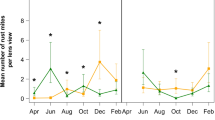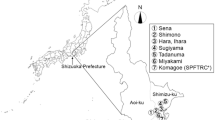Abstract
A survey of predaceous ground arthropods was conducted in two citrus orchards in Valencia, Spain, and their role as predators of Ceratitis capitata (Wiedemann) (Diptera: Tephritidae) pupae was evaluated under field and laboratory conditions. A total of 2959 predaceous arthropods were collected in pitfall traps in the two orchards from July 2003 to September 2004. Ants (Hymenoptera) were the most abundant group (83.61%), followed by Staphylinidae (7.77%), Araneae (5.24%), Dermaptera (2.13%), Carabidae (0.64%) and Cicindelidae (0.61). Pupae disappearance rates were higher during the warmer months of the year, from May to October, and in the orchard with the largest ant population. In the warm season, the mean survival of C. capitata pupae was 35.7±6.2% and 14.3±6.7%, respectively, in both orchards. Patterns of predation, inferred from broken or abnormal pupae, were more frequently observed in the colder months, from November to April, when spiders, Staphylinidae and other predators were present. In the cold season, the combined effect of predation and low temperature led to an adult emergence rate of 26.7±9.9% and 13.0±7.5% in both orchards. In no-choice laboratory trials, all predator species tested fed at significantly different rates on C. capitata pupae. Preliminary data show that the Carabids, Pseudophonus rufipes (Duftschmid) and Harpalus distinguendus (Degeer), were the most voracious species, consuming more than one pupa per day.
Similar content being viewed by others
References
Allen W.R. and Hagley E.A. (1990). Epigeal arthropods as predators of mature larvae and pupas of the apple maggot (Diptera: Tephritidae). Environ. Entomol. 19: 309–312
Alvis, L. 2003. Identificación y abundancia de artrópodos depredadores en los cultivos de cítricos Valencianos. Ph.D. Thesis. Dep. Ecosistemas Agroforestales. ETSIA. Universidad Politécnica de Valencia. 189 pp.
Bateman M.A. (1974). Fruit flies. In: Delucchi, V.L. (eds) Studies in Biological Control. IBP 9, pp 11–49. Cambridge University Press, Cambridge
Castañera P. (2003). Control integrado de la mosca mediterránea de las frutas (Ceratitis capitata) en el Comunidad Valenciana. Phytoma España 153: 131–133
DeBach P. and Rosen D. (1991). Biological Control by Natural Enemies. Cambridge University Press, Cambridge
Debouzie D. (1989). Biotic mortality factors in tephritid populations. In: Robinson, A.S. and Hooper, G. (eds) World Crop Pests, Vol. 3B, Fruit flies, pp 221–227. Elsevier, New York
Del Pino, A. 2000. Efecto de factores abióticos y edáficos naturales en el ciclo biológico de Ceratitis capitata (Wiedemann), Diptera: Tephritidae. Ph.D. Thesis. Dep. Producción Vegetal. ETSIA. Universidad Politécnica de Valencia. 217 pp
EPPO (European and Mediterranean Plant Protection Organization). 2004. Distribution Maps of Quarantine Pests for Europe. Ceratitis capitata. http://www.eppo.org/QUARANTINE/insects/Ceratitis_capitata/CERTCA_map.htm (27/10/04)
Eskafi F.M. and Kolbe M.M. (1990). Predation on larval and pupal Ceratitis capitata (Diptera: Tephritidae) by the ant Solenopsis germinata (Hymenoptera: Phormicidae) and other predators in Guatemala. Environ. Entomol. 19: 148–153
Galli J.C. and Rampazzo E.F. (1996). Enemigos naturales predadores de Anastrepha (Diptera, Tephritidae) capturados con trampas de gravedad de suelo en huertos de Psidium guajava L. Bol. San. Veg. Plagas 22: 297–300
Haney P.B., Luck R.F. and Moreno D.S. (1987). Increases in densities of the citrus red mite, Panonychus citri (Acarina: Tetranychidae), in association with the Argentine and, Iridomyrmex humilis (Hymenoptera: Formicidae), in Southern California citrus. Entomophaga 32: 49–57
Hennessey M.K. (1994). Depth of pupation of caribbean fruit fly (Diptera: Tephritidae) in soils in the laboratory. Environ. Entomol. 23: 1119–1123
Hodgson P.J., Sivinski J., Quintero G. and Aluja M. (1998). Depth of pupation and survival of fruit fly (Anastrepha spp.: Tephritidae) pupae in a range of agricultural habitats. Environ. Entomol. 27: 1310–1314
Hölldobler B. and Wilson E.O. (1996). Viaje a las hormigas. Una historia de exploración científica. Crítica Grijalbo Mondadori, Barcelona, 270
INM, 2004. Valores climatológicos normales. Instituto Nacional de Meteorología. Ministerio de Medio Ambiente. http://www.inm.es/. (26/11/2004)
Jiggins C., Majerus M. and Gough U. (1993). Ant defense of colonies of Aphis fabae Scopoli (Hemiptera. Aphididae), against predation by ladybirds. Br. J. Entomol. Nat. Hist. 6: 129–138
Liquido N.J., Shinoda L.A. and Cunningham R.T. (1991). Host plants of the Mediterranean fruit fly, Ceratitis capitata (Wiedemann) (Diptera:Tephritidae): an annotated world review. Misc. Publ. Entomol. Soc. Am. 77: 1–52
Palacios R., Martínez-Ferrer M.T. and Cerdà X. (1999). Composición, abundancia y fenología de las hormigas (Hymenoptera: Formicidae) en campos de cítricos de Tarragona. Bol. San. Veg. Plagas 25: 229–240
Papadopoulos N.T., Carey J.R., Katsoyannos B.I. and Kouloussis N.A. (1996). Overwintering of the Mediterranean fruit fly (Diptera: Tephritidae) in northern Greece. Ann. Ent. Soc. Amer. 89: 526–534
Papadopoulos N.T., Katsoyannos B.I. and Nestle D. (2003). Spatial autocorrelation analysis of a Ceratitis capitata (Diptera: Tephritidae) adult population in a mixed deciduous fruit orchard in Northern Greece. Environ. Entomol. 32: 319–326
Pemberton C.E. and Willard H.F. (1918). A contribution to the biology of fruit-fly parasites in Hawaii. J. Agric. Res. 15: 419–465
Primo E., Alfaro F. and Argilés R. (2003). Plan de actuación contra la mosca de las frutas (Ceratitis capitata) en la Comunidad Valenciana. Phytoma España 153: 127–130
Putruelle, M.T.G. 1998. Estudios bioecológicos de Ceratitis capitata Wiedemann (Diptera: Tephritidae). Ph.D. Thesis. Dep. Producción Vegetal. ETSIA. Universidad Politécnica de Valencia. 200 pp.
Queiroz J.M. and Oliveira P.S. (2001). Tending ants protect honeydew-producing whiteflies (Homoptera: Aleyrodidae). Environ. Entomol. 30: 295–297
Reimer N.J., Cope M.L. and Yasuda G. (1993). Interference of Pheidole megacephala (Hymenoptera: Formicidae) with biological control of Coccus viridis (Homoptera: Coccidae) in coffee. Environ. Entomol. 22: 483–488
Ripollés J.L., Marsà M. and Martínez M.T. (1995). Desarrollo de un programa de control integrado de las plagas de los cítricos en las comarcas del Baix Ebre-Montsià. Levante Agrícola 332: 232–248
Samways M.J., Grout T.G. and Prins A.J. (1998). Ants as citrus pests. In: Bedford, E.C.G. and Villiers, E.A. (eds) Citrus Pests in The Republic of South Africa, pp 234–242. Institute for Tropical and subtropical crops, Nelspruit
Serit M. and Tan K.H. (1990). Immature life table of a natural population of Dacus dorsalis in a village ecosystem. Crop Pest Management 36: 305–309
(1999). SPSS Manual del usuario, versión 10.0 para Windows 98. SPSS, Chicago, IL, 581
Wong T.T.Y., McInnis D.O., Nishimoto J.I., Ota A.K and Chang V.C.S. (1984). Predation of the Mediterranean fruit fly (Diptera:Tephritidae) by the argentine ant (Hymenoptera: Formicidae) in Hawaii. J. Econ. Entomol. 77: 1454–1458
Author information
Authors and Affiliations
Corresponding author
Rights and permissions
About this article
Cite this article
Urbaneja, A., Marí, F.G., Tortosa, D. et al. Influence of Ground Predators on the Survival of the Mediterranean Fruit Fly Pupae, Ceratitis capitata, in Spanish Citrus Orchards. Biocontrol 51, 611–626 (2006). https://doi.org/10.1007/s10526-005-2938-6
Received:
Accepted:
Published:
Issue Date:
DOI: https://doi.org/10.1007/s10526-005-2938-6




